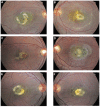A Korean family with an early-onset autosomal dominant macular dystrophy resembling North Carolina macular dystrophy
- PMID: 17302207
- PMCID: PMC2908855
- DOI: 10.3341/kjo.2006.20.4.220
A Korean family with an early-onset autosomal dominant macular dystrophy resembling North Carolina macular dystrophy
Abstract
Purpose: To characterize and report the phenotype of a Korean family with an early-onset autosomal dominant macular dystrophy resembling North Carolina macular dystrophy (NCMD).
Methods: Five members of a Korean family were examined clinically and underwent fundus photography, fluorescein angiography, indocyanine green angiography, optical coherence tomography, full field electroretinogram (ERG), multifocal ERG, electro-oculography (EOG), a color vision test, and a visual field test.
Results: Visual acuity ranged from 20/200 to 20/20. Fundus findings demonstrated varying degrees of involvement ranging from drusen only to chorioretinal involvement. Central scotoma corresponded to retinal lesions in two patients. Full field ERG was normal but multifocal ERG showed decreased amplitude and delayed implicit time in the macular area. EOG was normal except in one patient. Color vision tests were also normal.
Conclusions: The phenotype of this Korean family is consistent with NCMD. Linkage analysis is required to confirm the diagnosis.
Figures




Similar articles
-
A reappraisal of the clinical spectrum of North Carolina macular dystrophy.Ophthalmology. 2009 Oct;116(10):1976-83. doi: 10.1016/j.ophtha.2009.03.028. Epub 2009 Jul 18. Ophthalmology. 2009. PMID: 19616854
-
Multimodal Imaging and Functional Testing in a North Carolina Macular Disease Family: Toxoplasmosis, Fovea Plana, and Torpedo Maculopathy Are Phenocopies.Ophthalmol Retina. 2019 Jul;3(7):607-614. doi: 10.1016/j.oret.2019.03.002. Epub 2019 Mar 13. Ophthalmol Retina. 2019. PMID: 31043363
-
Non-familial occult macular dystrophy.Doc Ophthalmol. 2005 Jul;111(1):49-56. doi: 10.1007/s10633-005-4146-1. Epub 2006 Feb 25. Doc Ophthalmol. 2005. PMID: 16502307
-
Occult Macular Dystrophy.Adv Exp Med Biol. 2018;1085:103-104. doi: 10.1007/978-3-319-95046-4_19. Adv Exp Med Biol. 2018. PMID: 30578492 Review.
-
[Hereditary macular degenerations].Ber Zusammenkunft Dtsch Ophthalmol Ges. 1975;(73):695-735. Ber Zusammenkunft Dtsch Ophthalmol Ges. 1975. PMID: 1106398 Review. German. No abstract available.
Cited by
-
A novel duplication involving PRDM13 in a Turkish family supports its role in North Carolina macular dystrophy (NCMD/MCDR1).Mol Vis. 2021 Sep 1;27:518-527. eCollection 2021. Mol Vis. 2021. PMID: 34526759 Free PMC article.
-
New Noncoding Base Pair Mutation at the Identical Locus as the Original NCMD/MCDR1 in a Mexican Family, Suggesting a Mutational Hotspot.J Vitreoretin Dis. 2023 Jan 2;7(1):33-42. doi: 10.1177/24741264221129432. eCollection 2023 Jan-Feb. J Vitreoretin Dis. 2023. PMID: 37008391 Free PMC article.
-
Two novel non-coding single nucleotide variants in the DNase1 hypersensitivity site of PRDM13 causing North Carolina macular dystrophy in Korea.Mol Vis. 2024 Feb 19;30:58-66. eCollection 2024. Mol Vis. 2024. PMID: 38601016 Free PMC article.
-
Clinical and genetic characterization of a Danish family with North Carolina macular dystrophy.Mol Vis. 2010 Dec 9;16:2659-68. Mol Vis. 2010. PMID: 21179233 Free PMC article.
-
A novel tandem duplication of PRDM13 in a Chinese family with North Carolina macular dystrophy.Graefes Arch Clin Exp Ophthalmol. 2022 Feb;260(2):645-653. doi: 10.1007/s00417-021-05376-w. Epub 2021 Aug 24. Graefes Arch Clin Exp Ophthalmol. 2022. PMID: 34427740
References
-
- Lefler WH, Wadsworth JAC, Sidbury J. Hereditary macular degeneration and aminoaciduria. Am J Ophthalmol. 1971;71:224–230. - PubMed
-
- Frank HR, Landers MB, 3rd, Williams RJ, Sidbury JB. A new dominant progressive foveal dystrophy. Am J Ophthalmol. 1974;78:903–916. - PubMed
-
- Small KW, Hermsen V, Gurney N, et al. North Carolina macular dystrophy and central areolar pigment epithelial dystrophy. One family, one disease. Arch Ophthalmol. 1992;110:515–518. - PubMed
MeSH terms
LinkOut - more resources
Full Text Sources
Medical

